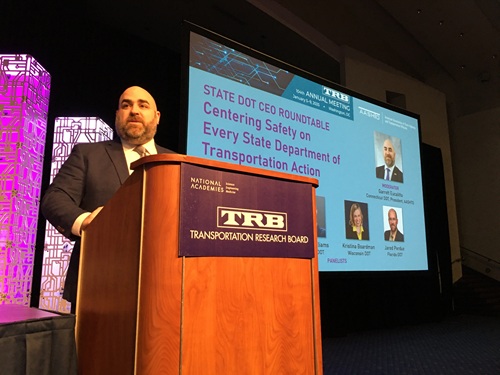A roundtable session at the 2025 Transportation Research Board Annual Meeting in Washington, D.C., featured a cross section of state department of transportation chief executives discussing how the state DOT community is making safety a core focus of the infrastructure work under their purview.
[Above photo by AASHTO]
The session also delved into how making the nation’s road network safer for all roadway users – including pedestrians, bicyclists, highway workers, and others – often requires a look beyond solely infrastructure solutions to the need for behavioral changes as well.
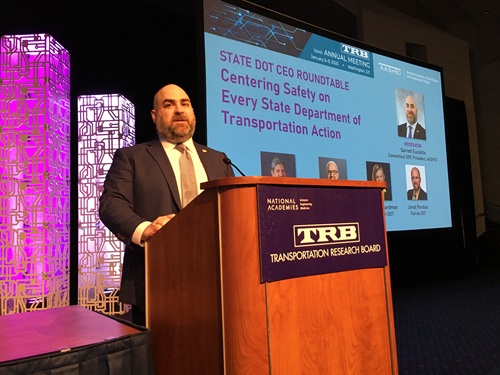
“Roadway safety continues to be a public health crisis in the U.S.,” stressed session moderator Garrett Eucalitto, commissioner of the Connecticut Department of Transportation and the 2024-2025 president of the American Association of State Highway and Transportation Officials.
“We in the transportation industry all say – and rightfully so – that safety is our top priority,” he explained.
“That means safety should be at center of all the decisions we make as state DOTs,” he said.
“But while we’ve been focused on building safe infrastructure for all users, we’ve been seeing increases in impaired driving, distracted driving, and speeding,” Eucalitto said. “So we need to leverage the knowledge of the collective AASHTO membership to help state DOTs better use technological advancements to make our roadways safer, along with ways to encourage broader adoption of safe and responsible driving behaviors.”
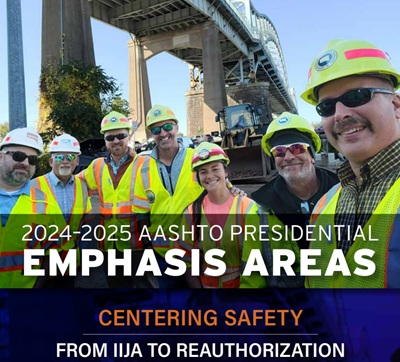
[Editor’s note: “Centering Safety” is the key theme of Eucalitto’s emphasis areas for his one-year term as AASHTO’s president; placing safety at the center of all actions made by state DOTs, resulting in safer communities, safer users, and safer workers].
For example, Jared Perdue – secretary of the Florida Department of Transportation – noted that designing and building safe infrastructure has been his top priority over his whole 30 year career in the industry. “We have that whipped, I think – we know how to build safe infrastructure,” he said.
Yet Perdue also noted that building safe transportation infrastructure has not delivered a “significant statistical impact” on reducing traffic injuries and fatalities.
“We have to acknowledge that, while we are passionate on safety, infrastructure may not be having an actual direct impact on bringing those numbers down,” he said. “That’s because we’ve found a lot of crashes are caused by behavior. So no matter how safe we make infrastructure, the behavior is still the main catalyst for injuries and fatalities.”
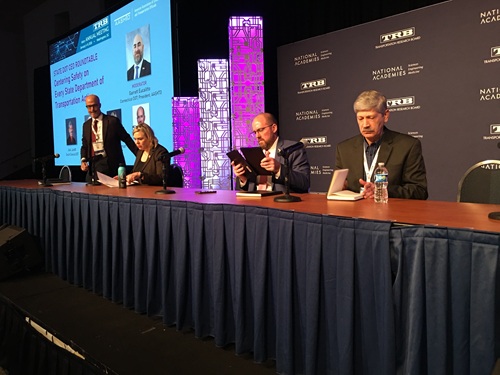
Marc Williams, executive director of the Texas Department of Transportation, noted his agency – like most state DOTs – challenges itself to look at every project as a safety project. Even with roadway maintenance projects, “we will add rumble strips, thicker lane markings, turn lanes, and pull offs in rural areas. Our teams look at adding those in the projects we undertake.”
Despite adding such infrastructure measures, the spike in traffic fatalities that occurred during the COVID-19 pandemic provides a stark illustration of how infrastructure is not sole solution to driving roadway safety improvements.
“We witnessed a significant rise in traffic fatalities during the pandemic – a 23 percent increase,” he said. “That occurred while VMT [vehicle miles travelled] went down. And note that, over that [COVID-19] time period, the infrastructure did not change – we are still using the same infrastructure as we were using before the pandemic. One of things we saw, though, is that there was a ‘mindset change.’ There was less traffic, there was less enforcement, and so people put the accelerator down.”
So, while state DOTs spend “a lot of time” reviewing infrastructure design standards, “that is only one third of the safety problem. The other two-thirds encompass driver behavior,” he said.
Williams did note, however, that the traffic numbers are beginning to show improvement, with the spike in injuries and fatalities that occurred during the pandemic having fallen by half as of 2024. “That shows we are making progress while ‘swimming upstream’ as VMT continues to grow,” he pointed out. “We are getting closer to the pre-pandemic fatality rate now. So, statistically, we see positive signs, but we all agree we need to do much better.”
Doing “better” means building a more robust safety culture across the transportation industry while collaborating with more public and private sector partners, such as law enforcement, highway contractors, etc.
“The old adage is that if you talk the talk, you must walk the walk,” stressed Joel Jundt, secretary of the South Dakota Department of Transportation. “So what are we doing [as state DOTs] to change this? We can all stand up here and say ‘change the behavior,’ but if we don’t make behavior changes [while driving] ourselves, then we are just as guilty. So we must hold ourselves accountable first.”
Using data is also key to helping communities encourage changes to driver behavior as well as accept the deployment of proven safety infrastructure, he said.
“Data-driven is the key to help the public understand the ‘why’ behind the safety efforts,” he said. That includes regularly communicating with the public to help get “buy-in” regarding infrastructure projects, especially ones aimed at improving safety Jundt noted.
Kristina Boardman, secretary of the Wisconsin Department of Transportation, echoed Jundt on the importance of that communication connection.
“We need to change how we communicate with the public because we have tried a lot of different things, but they are not making a huge difference in the [traffic] injury and fatality numbers,” she said.
Boardman added that creating “common threads” to bring all parties within a community together to help foster new ways to improve safety is vital. “It is a little bit of a give and take; we need to get buy-in from the community,” she pointed out. “But we need to figure out where the critical demographics are and how to communicate with them; that is one of the more important things we can do in terms of improving safety.”
 Top Stories
Top Stories
Modal Administrators Speak at AASHTO Annual Meeting
December 5, 2025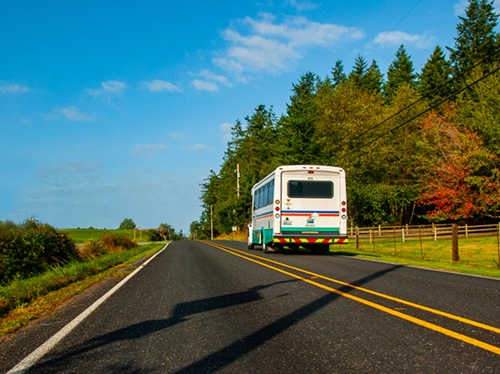 Top Stories
Top Stories
